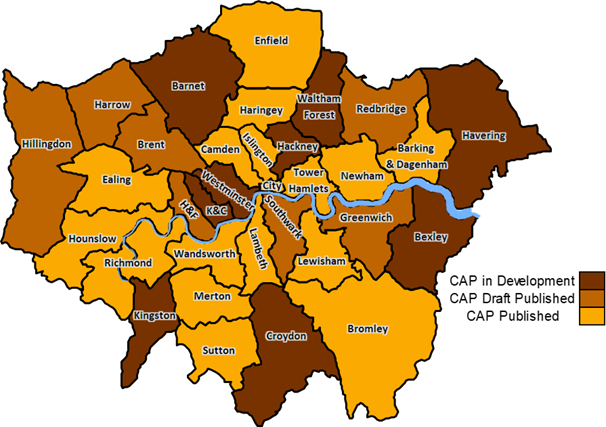Overview
This review is based on what is contained in the publicly available CAPs, or drafts that have been shared with London Councils before publication. Actions within these CAPs have been inputted into a database to show the alignment with London Councils seven climate programmes (see Table 1). In conjunction, a finance survey of London Deputy Treasurers Group was undertaken in March 2021 to examine CAP costs, funding sources and the climate-related financial challenges that boroughs face.
We recognise that a huge volume of effort and expertise has gone into the development of each individual CAP and there is much to learn from every one of them. It is also noted that boroughs do not always refer to these plans as a ‘Climate Action Plan’.
Table 1 – London Councils climate programmes and the lead boroughs
| Climate Programme | Lead boroughs |
| 1. Retrofit London | Enfield and Waltham Forest |
| 2. Low carbon development | Hackney and Tower Hamlets |
| 3. Low carbon transport | Kingston upon Thames |
| 4. Renewable power for London | Islington |
| 5. Renewable consumption emmissions | Harrow |
| 6. Build the green economy | Hounslow |
| 7. Creating a resilient and green London | Southwark |
Figure 1 - Borough CAP publication status as of April 2021
Analysis
This review finds that, of the 24 CAPs so far published in full or draft form, there are a wide variety of approaches to data sources, length and scope of activities. The earliest date for achieving net zero carbon for the council’s own emissions (sometimes referred to as ‘carbon neutral’) is 2025, but most boroughs have set 2030 as their target. For borough-wide emissions there is a more varied picture of target dates, but most boroughs are aiming to achieve net zero before 2040 – well ahead of the UK’s statutory 2050 target.
CAPs and the Climate Programmes
There are 2,166 actions contained within the 24 published CAPs, which have been grouped into 302 specific actions. When assessed against the London Council Climate Programmes, we can see that 83 per cent the actions fall within the seven thematic areas, but some programmes – such as Retrofit and Low carbon transport – are much more strongly represented within the borough CAPs than others – such as Low carbon development and Green economy.
- Retrofit: This is the focus for many boroughs, with well-developed activities. There is evidence of plans for not only the retrofit of council estates, social housing and schools, but also proactive support for retrofit in the private rental sector and businesses. The finance survey found that this is expected to be the most expensive climate programme (11 boroughs estimate it will cost £50m+); however, this may partly reflect the fact that the costs for this programme are relatively well understood.
- Low carbon development: This is a smaller theme in general, but contains several actions supporting net zero standards for new developments, as well as securing funds through carbon offsetting. Links with other programmes are also drawn out around biodiversity and active travel standards for new developments.
- Low carbon transport: This is the largest theme by the number of actions in CAPs and reflects the important role that boroughs play in transport decarbonisation in the capital. Partnership activities with Transport for London are well developed, for examples around electric vehicles, buses and the extension of the Ultra Low Emissions Zone.
- Renewable power: Popular actions around district heating networks and switching to green electricity dominate this programme in the CAPs, but there is scope for wider uptake of, for instance, community energy schemes and renewable power generation on council estates, which are only mentioned in a few CAPs.
- Reduce consumption emissions: Drivers for sustainable procurement practices are well supported in CAPs, but there is scope to support more action around emissions associated with supply chains, both at the council and individual resident level. This work is being aided by the Carbon Emissions Accounting Task and Finish Group, which has been convened by London Councils to support a common understanding and consistent approach to emissions accounting across the boroughs.
- Green economy: This is the theme that is least prominent in the CAPs, with seven boroughs having no actions on this theme at all. This reflects the fact that the actions in this theme are more about influencing than direct control; nonetheless, there is great potential to expand on the business networks mentioned here, and draw in other partners such as educational establishments on green skills and job creation.
- Resilient and green London: This is another broad theme that is well-served by the CAPs, with strong coverage for tree planting, biodiversity, and flood mitigation. Further actions on not just the mitigation of climate change but adaptation measures could increase alignment with this programme.
The 17 per cent of actions that do not sit within one of the seven climate programme themes are covered under:
- Air quality: This is the smallest theme, with a strong overlap with the objectives for the low carbon transport programme, and important links to improving health outcomes.
- Enabling the council to act: This theme has many actions concerning the development, prominence and governance of the CAPs themselves, but also addresses embedding climate in council decision making and sourcing funding, financing and grant opportunities for climate action. There is also prominence given to collaborative lobbying on climate more broadly.
- Enabling others to act: This theme covers the outreach to residents, businesses, public sector partners and other organisations through councils’ various communication plans and networks to build a broader coalition for climate action in the local area.
CAP Resourcing
Nine boroughs provided a cost estimate for their CAPs in the finance survey. While assumptions, including time periods, varied, the total estimated CAP costs provided by those nine boroughs was over £11 billion. While it is not yet possible to estimate a robust pan-London figure, initial modelling suggests the total cost of delivering commitments for all boroughs who have published net zero targets could potentially exceed £30 billion. Further work will be undertaken with boroughs to develop a consistent approach in order to provide a clearer understanding of the resource costs of CAPs – and provide a robust pan-London estimate. It is, however, already clear that only a very small proportion of the funds that will be needed is currently available to boroughs.
Collaboration
Two broad approaches to collaboration and community engagement have been taken alongside boroughs’ consultations on CAPs: citizen assemblies and summits; and environment networks made up of residents, the council and other experts. There are a wide number of partners engaged across various external organisations and levels of government. These include the voluntary sector, educational institutions and local businesses, among others. However, there are gaps in engagement, including around health. Regional collaboration between boroughs is only infrequently mentioned; lobbying actions are overwhelmingly targeted at national government, or on working with other organisations to lobby government for legislative change or increased funding.
Challenges
Alongside a wide array of innovation and best practice, this review identifies a range of challenges:
- The diversity of CAPs may hamper collaboration and peer learning
- The diversity of CAPs may obscure common priorities and the links through to the seven climate programmes
- Stakeholder engagement does not always reach key sectors
- There is potential for confusion on the priorities for action amongst residents
- There is not a complete picture of what resources are needed to deliver CAPs or where these resources will be found
- There are important areas of climate action not captured by the seven climate programmes.
Recommendations
A series of recommendations have emerged from the review, in summary, these address:
- How CAPs should evolve and what they should include
- How CAPs could encourage greater collaboration
- How CAPs could engage and communicate more effectively
- How London Councils and other pan-London organisations can support the CAPs, including ReLondon, WDAs, Society of London Treasurers and the London Environment Directors’ Network.
Commentary
From these recommendations it is hoped that this review can help boroughs develop their plans and provide a useful survey of current practice, while also pointing the way to how boroughs can individually and collectively strengthen delivery in this critical area of work.


